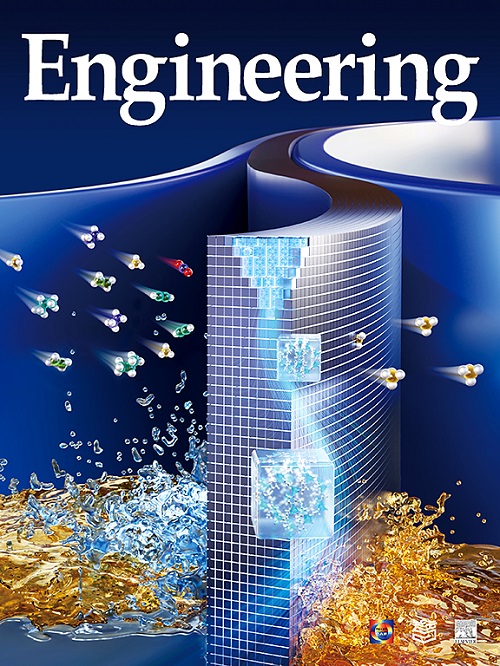靶向IGF2BP2-CEMIP促进小鼠结直肠癌抗血管生成治疗
IF 11.6
1区 工程技术
Q1 ENGINEERING, MULTIDISCIPLINARY
引用次数: 0
摘要
血管生成是支持肿瘤进展和转移的必要条件。然而,表转录组在调节血管生成中的潜在作用仍不清楚。在这里,我们发现RNA n6 -甲基腺苷(m6A)阅读器胰岛素样生长因子2 (IGF2)信使RNA (mRNA)结合蛋白2 (IGF2BP2)是高血管结直肠癌(CRC)中最富集的m6A调节因子,其表达与不良预后相关。CRC细胞中IGF2BP2的敲低抑制了其在体外促进内皮细胞促血管生成表型的能力,以及体内血管异常、肿瘤进展和转移的能力。支持这些发现的是,肠道特异性Igf2bp2敲入小鼠通过增强血管生成和血管异常,表现出氮氧甲烷(AOM)加葡聚糖硫酸钠(DSS)诱导的结直肠癌加速,而肠道特异性Igf2bp2敲入小鼠通过使肿瘤血管系统正常化抑制肿瘤生长。机制上,IGF2BP2与m6a修饰的细胞迁移诱导和透明质酸结合蛋白(CEMIP) mRNA结合,增强其稳定性,导致CEMIP分泌增加。分泌的CEMIP与内皮细胞上的膜葡萄糖调节蛋白78 (GRP78)相互作用,激活促血管生成信号。重要的是,通过基因消融靶向IGF2BP2,脂质纳米颗粒(LNP)包封小干扰IGF2BP2,或化学抑制剂(CWI1-2)与抗血管生成药物协同抑制多种CRC模型中的肿瘤生长。总之,这些发现表明,靶向IGF2BP2是一种有希望的策略,可以提高CRC抗血管生成治疗的疗效。本文章由计算机程序翻译,如有差异,请以英文原文为准。


Targeting IGF2BP2–CEMIP Boosts Antiangiogenic Therapy in Colorectal Cancer in Mice
Angiogenesis is essential for supporting tumor progression and metastasis. However, the potential role of the epitranscriptome in regulating angiogenesis remains unclear. Here, we identify the RNA N6-methyladenosine (m6A) reader insulin-like growth factor 2 (IGF2) messenger RNA (mRNA)-binding protein 2 (IGF2BP2) as the top enriched m6A regulator in hypervascular colorectal cancer (CRC), with its expression correlating with poor prognosis. Knockdown of IGF2BP2 in CRC cells suppressed their ability to promote pro-angiogenic phenotypes in endothelial cells in vitro, as well as vascular abnormalization, tumor progression, and metastasis in vivo. Supporting these findings, intestine-specific Igf2bp2 knock-in mice exhibited accelerated azoxymethane (AOM) plus dextran sulfate sodium (DSS)-induced CRC through enhanced angiogenesis and vascular abnormalities, whereas intestine-specific Igf2bp2 knockout inhibited tumor growth by normalizing tumor vasculature. Mechanistically, IGF2BP2 binds to m6A-modified cell migration inducing and hyaluronan binding protein (CEMIP) mRNA and enhanced its stability, leading to increased secretion of CEMIP. Secreted CEMIP interacts with membrane glucose-regulated protein 78 (GRP78) on endothelial cells, activating pro-angiogenic signaling. Importantly, targeting IGF2BP2 through genetic ablation, lipid nanoparticle (LNP)-encapsulated small interfering IGF2BP2, or the chemical inhibitor (CWI1-2) synergized with anti-angiogenic drugs to suppress tumor growth in multiple CRC models. Together, these findings suggest that targeting IGF2BP2 is a promising strategy to enhance the efficacy of anti-angiogenic therapy in CRC.
求助全文
通过发布文献求助,成功后即可免费获取论文全文。
去求助
来源期刊

Engineering
Environmental Science-Environmental Engineering
自引率
1.60%
发文量
335
审稿时长
35 days
期刊介绍:
Engineering, an international open-access journal initiated by the Chinese Academy of Engineering (CAE) in 2015, serves as a distinguished platform for disseminating cutting-edge advancements in engineering R&D, sharing major research outputs, and highlighting key achievements worldwide. The journal's objectives encompass reporting progress in engineering science, fostering discussions on hot topics, addressing areas of interest, challenges, and prospects in engineering development, while considering human and environmental well-being and ethics in engineering. It aims to inspire breakthroughs and innovations with profound economic and social significance, propelling them to advanced international standards and transforming them into a new productive force. Ultimately, this endeavor seeks to bring about positive changes globally, benefit humanity, and shape a new future.
 求助内容:
求助内容: 应助结果提醒方式:
应助结果提醒方式:


